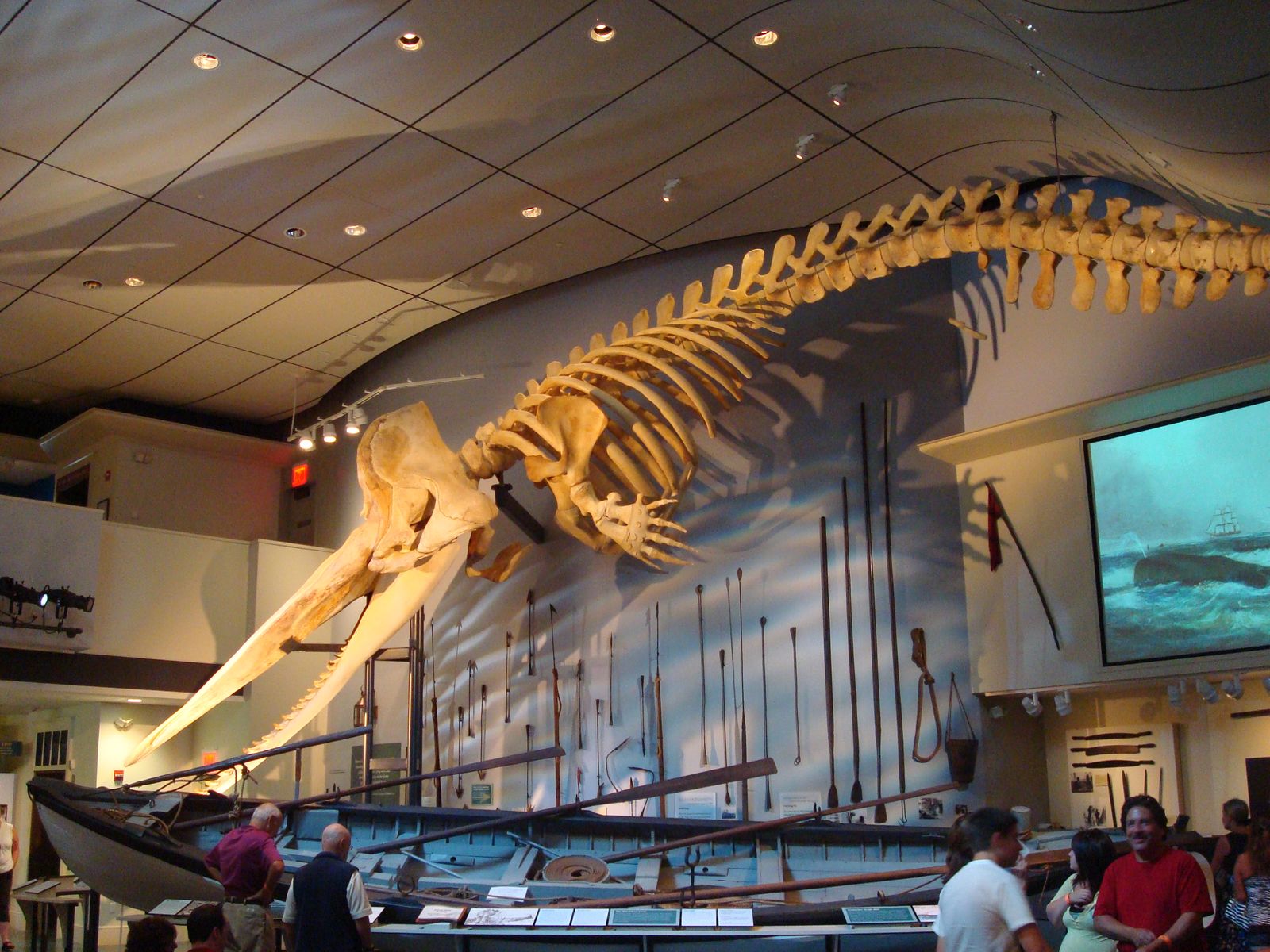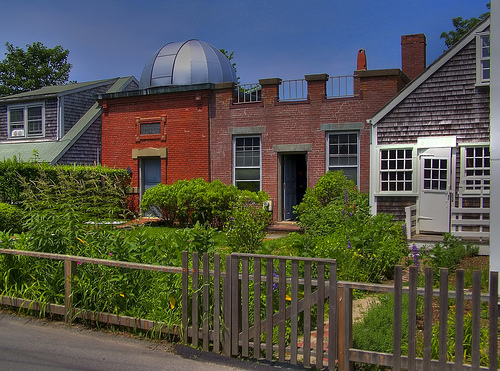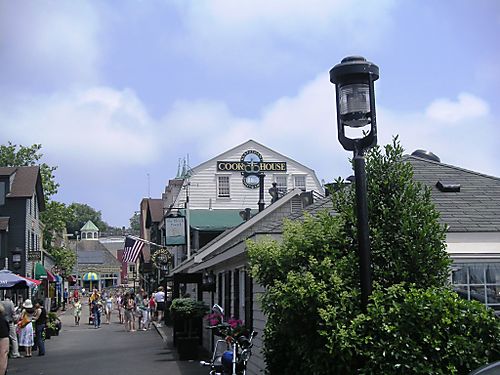In addition to the natural beauty of Nantucket's beaches, moors and coastline, the
Island's rich history is attractively and meticulously well-preserved. Right off
the ferry, one is struck by the charm of the cobblestone streets and beautifully-maintained
brick homes of Nantucket Town, including exquisite Nantucket vacation rentals.
And although special places like Siasconset (more familiarly known as 'Sconset)
or a sunset in Madaket also shouldn't be missed, there are three terrific sights
to enjoy right in Town:

Nantucket Whaling Museum
For nearly 100 years – from the mid-1700’s to the late 1830’s – Nantucket was the
whaling capital of the world with as many as 150 ships making port in Nantucket
during its peak. During the period 1820 to 1840, Nantucket’s population swelled
to 10,000 due to the industry created by whaling, making it the third largest city
in Massachusetts. Only Boston and Salem were larger.
The whaling ships of Nantucket actually sailed all around the world when the local
whaling waters were depleted. They were looking for right whales and if possible
sperm whales. Right whales were valued because they were slow swimmers, making them
easier to catch, and they floated high out of water, making them easier to tow back
to the ship. Sperm whales were harder to catch but each held a reservoir of valuable
spermaceti oil in their head. They brought prosperity to the small island due to
the demand for whale oil and bone for the making of scrimshaw.
In 1846, the “Great Fire” destroyed the wharves and much of the business district
in the town of Nantucket. This event, along with the dwindling demand for whale
oil, the silting-up of the harbor, and the California Gold Rush in 1849, all contributed
to the end of the whaling-era prosperity.
The Nantucket Historical Association’s Whaling Museum was first established in 1929.
After the Great Fire, the Mitchell family built the structure as a candle factory.
Candles were made from the oil pressed from whale blubber and spermaceti oil found
in whale heads. Two years later, it was purchased by local businessmen, William
Hadwen and Nathaniel Barney, who continued to use it to manufacture candles. For
about a dozen years beginning in 1860, the building was used for warehouse space
before being reconverted into offices for the New England Steamship Company in the
1870’s. In 1929, the building was purchased by the Nantucket Historical Association,
and the Whaling Museum was created.
In 2005, the Museum was fully restored and, in 2008, became accredited by the American
Association of Museums. While the centerpiece of the Museum is the complete skeleton
of a 46 foot bull sperm whale suspended from the ceiling, the Museum also houses
a large collection of whaling artifacts and memorabilia including longboats, harpoons,
and scrimshaw.
The museum's original use as a candle factory is well represented with exhibits
about that trade as well. The exhibited beam press is the only one in the world
still residing in its original location. Other exhibits include an 1849 Fresnel
lens used in the Sankaty Head Light and the restored workings of the Nantucket 1881
town clock.

Maria Mitchell Observatory
On a night in October of 1847, a woman stood on the roof of the Pacific National
Bank near her Nantucket home with a telescope. This was nothing new as Maria Mitchell
had, since childhood, a love for astronomy. At age 12, she and her father had pinpointed
the location of their Nantucket home by observing a solar eclipse. So adept was
Maria at astronomy that whaling captains trusted her to plot the navigation for
their whaling journeys. Throughout her young womanhood, she acquired astronomical
equipment and conducted observations.
But on this October night, she would discover a comet that didn’t appear on any
astronomical charts. The comet was named Comet Mitchell 1847VI. This discovery brought
Maria fame, and the following year she became the first woman to be appointed to
the Academy of Arts and Sciences.
The Maria Mitchell Association was founded in 1902, and in 1908 the Maria Mitchell
Observatory was built next door to her Vestal Street Nantucket home. This observatory,
with its newly restored dome, is actually one of two observatories maintained by
the Association – the other being the Loines Observatory west of town. The Loines
Observatory actually has two domes, one built in 1968 and the other in 1998.
The observatories are open for regular public tours, programs, and lectures and
also host several special events during the year. View a scale model of the solar
system, learn how to operate a sundial, and observe the night sky. For more information
or to view information on each month’s night sky, visit their website.

Shopping in Nantucket Wharf
Having fallen into disuse during the Depression following the demise of Nantucket’s
whaling industry, Nantucket's wharves and cottages sat empty and derelict. In 1920,
summer visitor Florence Lang, an amateur artist who lived in Montclair, New Jersey,
and her husband Henry acquired a group of rundown buildings that had formerly been
fishermen's shacks and boat-houses on the waterfront and renovated them for use
as artists' studios. She rented out the studios for what were then considered nominal
fees of fifty to seventy dollars per season.
Artists quickly filled the spaces to both live and work together amid simple, no-frills
conditions. Many returned year after year to their favorite studios. The colony
flourished, in no small part thanks to this affordable real estate.
During the disastrous economic conditions during and after the Great Depression,
high summer seasons on Nantucket surprisingly continued uninterrupted—a boon to
all concerned. The arts were then central to the economy, as they are today.
Less than a year after the stock market crashed, the first Sidewalk Art Sale was
launched in August of 1930 by illustrator and painter Maud Stumm (ca.1870-1935).
She had studied in France where open-air art markets were common. The sidewalk show
ran for a string of fair weather days every August. Featuring dozens of artists
from all levels of skill and divergent walks of life, it operated continuously for
more than fifty years—a child of the Depression that grew to be vigorously healthy.
The event consistently drew off-Island visitors.
Today Nantucket’s wharves are home to art galleries, crafts and jewelry shops and
restaurants, and they are a must-see when visiting the Island. The original architecture
has been well maintained, and many of the buildings are original.